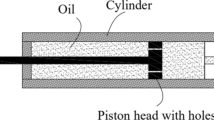Abstract
Squat reinforced concrete shear walls typically comprise the lateral force resisting system in nuclear facility structures. The geometry and thickness of these walls contribute to an extremely high initial lateral stiffness. When conducting a hybrid simulation, a high stiffness presents a challenge for determining the dynamic response of such walls because very small displacements must be controlled. An extension of the hybrid simulation technique using a digital displacement encoder for high-resolution displacement feedback was developed, implemented, verified, and validated. Then a hybrid model that represents a nuclear facility structure with a large-scale squat wall physical specimen was designed. A ground motion excitation was selected and scaled to represent specific performance levels. These preparations for hybrid simulations of the seismic response of squat shear wall specimens, subjected to different ground motion sequences, are presented to illustrate the new developments. Guidelines are provided for future implementations of feedback instruments for servo-hydraulic systems to conduct hybrid simulation tests.
Similar content being viewed by others
References
Gulec, C.K., and Whittaker, A.S. “Performance-Based Assessment and Design of Squat Reinforced Concrete Shear Walls,” Technical Report MCEER-09-0010, University at Buffalo, State University of New York at Buffalo, Buffalo, NY (2009).
Leon, R.T., and Deierlein, G.G., “Considerations for Use of Quasi-Static Testing,” Earthquake Spectra 12(1): 87–109 (1996).
Whyte, C.A., and Stojadinovic, B. “Hybrid Simulation of the Seismic Response of Squat Reinforced Concrete Shear Walls,” PEER Center Research Report No. 2013/02, May 2013, 1–196, (2013).
Rocks, J.F., Luna, B.N., and Whittaker, A.S. “Seismic Response of Low Aspect Ratio Reinforced Concrete Shear Walls,” Proceedings of the SMiRT 21, New Delhi, India; 2011.
Whyte, C.A. and Stojadinovic, B. Effect of Ground Motion Sequence on the Response of Squat Reinforced Concrete Shear Walls, Journal of Structural Engineering, 10.1061/(ASCE)ST.1943-541X.0000912, 2013.
Saouma, V.E., and Sivaselvan, M.V., Hybrid Simulation: Theory, Implementation and Applications, Taylor and Francis, London, UK (2008).
OpenSees, Open System for Earthquake Engineering Simulation (2013), URL http://opensees.berkeley.edu [accessed on 16 July 2013].
OpenFresco, Open Framework for Experimental Setup and Control (2014), URL http://openfresco.neesforge.nees.org [accessed on 16 July 2013].
Schellenberg, A., and Mahin, S. “Application of an Experimental Software Framework to Hybrid Simulation of Structures through Collapse,” 1st European Conference on Earthquake Engineering and Seismology, Geneva, Switzerland (2006).
MTS. Model 793.00 System Software, User Information and Software Reference, MTS Systems Corporation, Eden Prairie, MN (2003).
Mathworks, MATLAB, Simulink, Stateflow, xPC Target (2014), URL http://www.mathworks.com [accessed on 16 July 2013].
Systran. SCRAMNet + Network (2000), URL http://www.cwcdefense.com/products/iocommunication-boards/[accessed on 16 July 2013].
Schellenberg, A. Advanced Implementation of Hybrid Simulation, Ph.D. Thesis, University of California, Berkeley (2008).
Lai, J.W. Experimental and Analytical Studies on the Seismic Behavior of Conventional and Hybrid Braced Frames, Dissertation, Department of Civil and Environmental Engineering, University of California, Berkeley, Berkeley, CA (2012).
Huang, Y.N., and Whittaker, A.S. “Performance Assessment of Conventional and Base-Isolated Nuclear Power Plants for Earthquake and Blast Loadings,” Technical Report MCEER-08-0019, State University of New York at Buffalo, Buffalo, NY (2008).
Huang, Y.N., Whittaker, A.S., Kennedy, R.P., and Mayes, R.L. “Assessment of Base-Isolated Nuclear Structures for Design and Beyond-Design Basis Earthquake Shaking,” Technical Report MCEER-09-0008, State University of New York at Buffalo, Buffalo, NY (2009).
PEER NGA Database (2014), URL http://peer.berkeley.edu/peer_ground_motion_database [accessed on 16 July 2013].
Nakata, N. and Krug, E. Multi-Degrees-of-Freedom Effective Force Testing: A Feasibility Study and Robust Stability Assessment, Earthquake Engineering and Structural Dynamics 42(13): 1985–2002 (2013).
Author information
Authors and Affiliations
Corresponding author
Rights and permissions
About this article
Cite this article
Whyte, C., Stojadinovic, B. Use of a High-Precision Digital Displacement Encoder for Hybrid Simulation of Seismic Response of Stiff Specimens. Exp Tech 40, 677–688 (2016). https://doi.org/10.1007/s40799-016-0069-x
Published:
Issue Date:
DOI: https://doi.org/10.1007/s40799-016-0069-x




